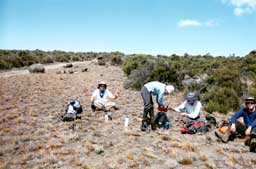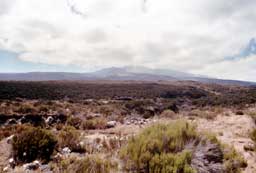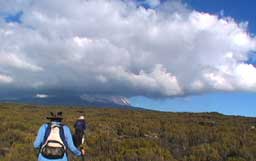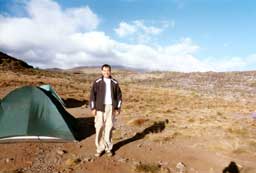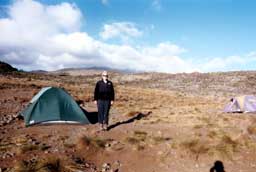Day
2 - Shira |
||||
The first part of the journey was to cross the almost rainforest-like woodlands that we toured the day before. The morning fog was fairly thick, providing a comfortable layer of airborne moisture we could taste with every breath. As the day wore on, the fog began to burn off while we crossed into a drier and drier environments. The tree forest was interrupted with the occasional plantation of various local crops, accompanied by huts we could see on the other side of their plantation. Some of these areas were being harvested as we passed through. As we pressed on, the trees became scarce, and the bushes became shorter and exchanged their green shades for light browns. It was arid, much like the Southern Californian mountains in the summer, and quite warm. Without the protective and nurturing canopy that the forest provides, this land was easily baked by the sun, evaporating the moisture. Our footsteps began to kick up the dust, enough to be worth avoiding. At midday, I noticed my newly rediscovered shadow was the "wrong" way: I knew I was hiking east, but my shadow pointed just barely to the right. Being that this was my first time in the Southern Hemisphere (albeit only 2 degrees south), I took a moment to understand the astronomical alignment that made my shadow point to the opposite of what I've observed since childhood. For our first lunch while on the trail, we stopped at a small clearing in the light brown bush. Our lunch consisted of a baby banana, an orange, a peanut-butter and jelly sandwich, baked chicken, a hard-boiled, reddish brown-shelled, white-yolked egg, finished off with two "Nice"-branded butter-breaded cookies, washed down with a carton of apple juice. The banana was good, the orange was messy but welcomely juicy, the sandwich was dry, but the hard-boiled egg was something we all had to get used to. Our lunchtime meals varied little from this recipe for the hike, but we figured that the egg and peanut butter gave it a high-protein content, something we'll need for our strength and our red blood cell count as our altitude rises and the hike becomes more strenuous. After passing 3000 m (10000 ft), we entered the region east of the main peak of Mount Kilimanjaro known as Shira Plateau. The Shira volcano was the first to erupt and grow into a large mountain. Later the crater that formed Mawenzi peak erupted much further east to distort the landscape. Finally, Kibo erupted between these two peaks, triggering the eldest Shira to flatten while growing to the height we know today. The result is a main peak that sits on its two sisters to the west and east, providing a flattened plateau for our western approach. Entering the Shira plateau was when we saw the main peak, Kibo, for the first time with our own eyes. At first it seemed not so big, just another mountain, but after taking a moment to assess how much ground lies ahead and the clouds shrouding the peak, we could see it was a really big mountain. Add that to the fact that we were almost 3300 m (11000 ft) high, the height of the peak of Mammoth mountain ski resort of California (already 2000 ft above the top of Lake Tahoe's ski resorts), and we can see that we are climbing a huge mass.
After taking a rest, we made our way across the Shira plateau to make camp before we lost the sun. The foliage changed to low, green desert-like shrubs, while the soil seemed not as dusty as we encountered before. Although our average climb seemed not as great, we had to scale varying terrain, diving down some crevasses to cross a few dried rivers. We weren't sure where the camp was. In fact there was a miscommunication with the porters where to establish the camp, so we crossed more ground that day than we had in mind. Making fast progress at the end of the day towards camp, we arrived just before sunset. This was fortunate. We arrived, tired and hungry, and the porters provided tubs of potable water for us to clean off our hands and faces. Our group of five was quite thankful for the water, saying "Asanté!" several times to the porters. But the sun set very promptly just after 6 pm, a consequence of being so close to the equator, that it soon became cold, so our cooks provided dinner for us. Very soon, our digestive processes conspired with the effort of the day, prompting us to bed. At 3800 m (12000 ft), we were now sleeping at a higher altitude than any of us had slept before, and that night we began to encounter its effects. The human body will naturally increase the number of red blood cells in the circulatory system in order to compensate for the limited oxygen in the air. To help prevent altitude sickness, four of us were prescribed Diamox, which we were taking since the flight, to give our bodies a further boost by thickening the blood. Diamox works by triggering the body to remove water. Darrell, unfortunately, was allergic to sulfa-based drugs such as Diamox, so he had to do without it. However, a further side effect was that each of us, some time in the night, woke up with a desperate need to empty our bladders! So, at some discomforting nighttime hour, we were introduced to going to bathroom in the cold! The bathroom consisted of a small wooden shack big enough to allow one person to aim through a hole in the floor, below which our refuse would land in a large pit. And beware when the last occupant missed! Toilet paper and wet wipes bundled in my jacket pockets, my experience came at 1 am, with the wind and the cold to urge me to take haste, even though the weight of my waste water was a vastly sufficient reminder. Once I satisfied my physiology, I could take a moment to appreciate my surroundings. The first thing I noticed was the stars, the beautiful stars this clear night presented for me to see. Bundled in gear I normally use for skiing mountain slopes in winter, I could stave off the cold winds to gaze in awe at the mass of starry light overhead. It was amazingly beautiful, and it had been years since I had seen so many stars at once. The Milky Way galaxy was plain to see, sprinkling its light from one horizon to another, making it obvious why the sight reminded ancient night watchers of scattered milk. I acquired my bearings as I studied the sight further to recognize constellations, but it was clear that this was not the sky I normally see in California. Being just below the equator, we were considerably further south. Our latitude was south enough for me to see the southern cross for the first time, as well as numerous southern stars that I never or had barely seen from my 33 degree north latitude home. I spent minutes absorbing the fabulous star light in the isolated surroundings and the quiet, save for the sound of our tents flapping in the wind. I stopped only for the cold. < HOME |
INTRODUCTION | DAY 1 |
DAY 2 | DAY 3 | DAY
4 | DAY 5 | DAY
6 > |
||||


